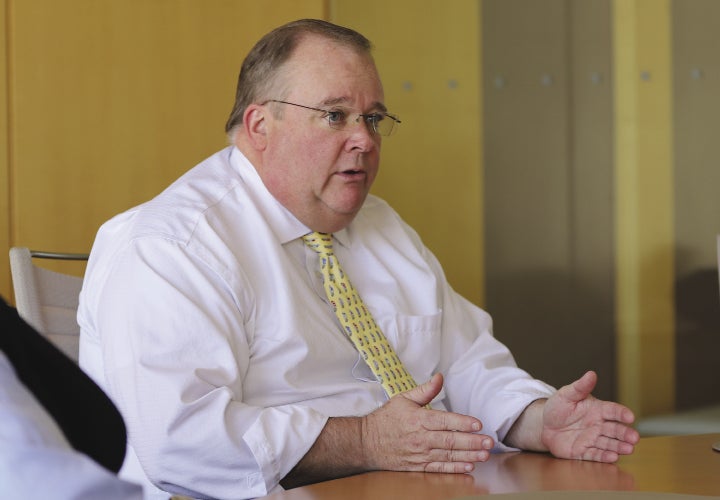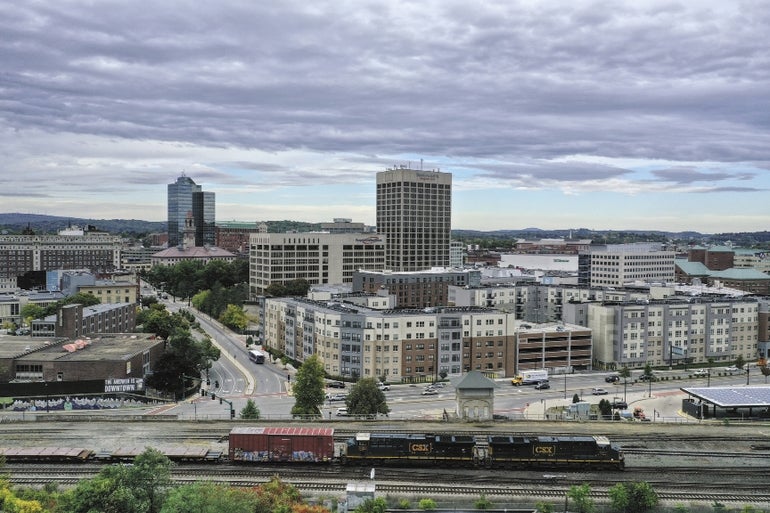Despite the rough past 16 months and the pandemic’s continued impact on the economy, local forecasters are optimistic about the short- and long-term future of the Central Massachusetts business community, especially as statewide restrictions have been lifted and vaccination rates rise.
Get Instant Access to This Article
Subscribe to Worcester Business Journal and get immediate access to all of our subscriber-only content and much more.
- Critical Central Massachusetts business news updated daily.
- Immediate access to all subscriber-only content on our website.
- Bi-weekly print or digital editions of our award-winning publication.
- Special bonus issues like the WBJ Book of Lists.
- Exclusive ticket prize draws for our in-person events.
Click here to purchase a paywall bypass link for this article.
Since February 2020, the U.S. has been mired in a recession, which has yet to officially end.
The global impact of the coronavirus pandemic threw industries, supply chains, and workforces in turmoil, which all hit the Central Massachusetts economy hard. The unemployment rate in the summer hit 17.4% in Worcester, which is the highest rate ever recorded in the city by the U.S. Bureau of Labor Statistics.
Despite the rough past 16 months and the pandemic’s continued impact on the economy, local forecasters are optimistic about the short- and long-term future of the Central Massachusetts business community, especially as statewide restrictions have been lifted and vaccination rates rise.
Kathleen Glowacki, Bartholomew & Co., Inc.
Glowacki, director of the investment management department at Worcester financial firm Bartholomew & Co. said Central Massachusetts is poised to effectively bounce back.

“A good sign is that in the first quarter of 2021, the broad Massachusetts economy expanded at rate nearly double that of the rest of the United States,” Glowacki said.
The industry composition of Central Massachusetts, combined with a quicker than anticipated vaccine rollout are all positive factors to help the region’s economy recover quicker, especially when compared to the rest of the U.S, she said.
The industries hit the hardest during the pandemic were those requiring a physical presence, such as leisure and hospitality but also manufacturing and construction, Glowacki said. While certain industries were directly impacted by the circumstances, the success/failure of companies really depended on their ability to quickly adapt.
“The pandemic tested business leaders and either proved, or disproved, good leadership. COVID forced many companies to redefine processes, become more flexible to change, be agile with changing comfortable business customs, etc. It was a true test of each individual company,” she said.
Small businesses will be the backbone of any financial recovery in the region, she said.
“Overall, far too much remains to be seen for the future economic landscape, but despite the challenges and changes caused by the pandemic, Central Mass. is in a strong position and recovery is underway,” Glowacki said.
John Regan, Associated Industries of Massachusetts
Regan, president and CEO of industry advocate AIM, expects Central Massachusetts will reflect the economic trajectory of the state.

“Economic output in the commonwealth rose at an annual rate of 11.3% in the first quarter and is projected to rise at 7.5% annual rate in the second quarter and 8.5% in the third quarter,” he said.
While the state’s vaccine rollout will help fuel economic recovery, Regan said persistent supply-chain disruptions in various industries, the price runup in the residential housing market, and employer’s inability to find qualified people to fill jobs, are all potential hurdles to slow down recovery progress.
“Sectors leading the recovery will include construction, especially if Congress is able to pass an infrastructure bill, and the region’s strong biopharmaceutical and technology base,” Regan said.
As the public becomes vaccinated and business restrictions are lifted, employers’ need for skilled workers will grow, resulting in a need for education and training, which Central Massachusetts is already equipped to fill, he said.
“The region is also fortunate to be a leader in worker training and education, whether through the Massachusetts Manufacturing Extension Partnership, vocational schools, community colleges or four-year institutions. Training will be pivotal to an economic recovery that is already running short of qualified workers in settings ranging from hotels to electronic assembly,” Regan said.
Childcare and other gendered barriers have created disproportionate employment numbers, he said. Along with female workforce retention issues needing to be resolved, Regan predicts work-at-home and hybrid meetings/schedules are aspects of the workforce here to stay.
“One of the lasting effects of the pandemic will be the unprecedented exodus of women from the Massachusetts workforce,” he said.
Jim Glassman & Rick MacDonald, J.P. Morgan
Glassman, commercial banking head economist for global bank J.P. Morgan, and MacDonald, its middle market banking region manager for J.P.Morgan Chase Commercial Banking, said Central Massachusetts could outpace the state, on average.

“Looking at Worcester’s numbers, you guys are doing much better than the state,” Glassman said.
He said Central Massachusetts’ focus on medical and education industries, especially in Worcester, are responsible for these positive figures. While dense, urban areas were hit the hardest, Glassman is optimistic and believes numbers will continue to strengthen this year and the next.
Three elements that are aiding economic recovery, Glassman said: 1) Fiscal supports due to an accumulated backlog of money. 2) More money in the pipeline due to $1.9-trillion COVID-19 relief bill. 3) The Federal Reserve keeping rates artificially low until “we get where we need to be”.
“The most impressive growth will be in the areas/sectors that were hit the hardest,” Glassman said.

These sectors include hospitality, medical, education, and the restaurant industry. Because of social distancing guidelines, the service industries suffered the greatest. However, Glassman said the public is desperate to return to a sense of normalcy and wants to get out of their homes after months of lockdowns. As a result, this will aid in the rapid recovery of service industries.
Glassman said GDP may have returned to pre-pandemic levels, but employment has not. As a result, the goal is to re-energize the workforce and get Americans back to work.
Glassman and MacDonald agree domestic travel is skyrocketing since the public wants to travel but is still wary about international excursions due to COVID-19 safety. MacDonald said this change in travel habits greatly benefits the domestic economy as travelers explore the U.S. and keep their spending in this country, which benefits areas such as Central Massachusetts by attracting tourists.
MacDonald said during the coming year the public’s urge to retain a sense of normalcy will drive economic recovery.
“Going to be like the Roaring 20s. It’s going to be one big party,” he said.
While the service industries were greatly impacted, demand for physical goods exploded and stabilized. Glassman and MacDonald attribute the growth of physical goods to the vast increase of online shopping and home renovations as people were stuck in their homes. Their clients who worked in industries such as home improvement, auto sales, and physical good manufacturing did extraordinarily well.
The pandemic accelerated the course that companies were already destined to follow, MacDonald said. For example, if companies already had an online presence as part of their business plan or were already looking at transitioning online, then they had the ability to quickly adapt to the pandemic. However, companies already mismanaged or facing decline were unable to convert their models quickly enough to withstand the pandemic.
“This is the one event where it wasn’t a fizzle or a bubble, but the government shut everything down. It was a brick wall,” he said.
Glassman said a new energy is in the economy as new businesses were opened during the pandemic.
Within each business sector, MacDonald described individual businesses as balancing each other out since some businesses were able to adapt, find niches, and thrive during the pandemic while other companies had issues and struggled.

